
Hiking in Hrvastka
September 15, 2007 – October 2, 2007
 |
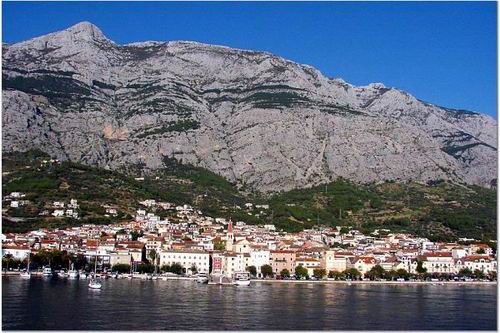 |
|
|
When I read in the Elderhostel catalog of last year the information about the bicycling program in Hungary, I signed up for it. The country was not readily open to people living outside the Soviet Union therefore, I was intrigued to see what their life was like. The same reasoning was used for my hiking trip in Croatia. I have heard so much about the country. Later, I discovered that Croatia seems to have been developed more than Hungary, but not in Budapest. In Hungary, the old communist stereotyping that existed in my subconscious still lingers, especially among the older generation.
Croatia, which the natives call Hrvastka ( pronounced Khervastka) is located along the Adriatic Sea opposite Italy. The Slavic population of five million is mainly Catholic, its language is Slavic written in Latin. The country is a member of the EU and NATO. The main unit of its currency is the Kuna, which has not yet changed to the Euro.
I took the opportunity to spend a couple of days visiting my friends Clara Ospina and her husband John White in Treviso, which is in the vicinity of Venice. Her email to me was a kind invitation to their home and town. My expose' on the visit is shown on Page 3.
Croatia:
From Venice, I flew to Split, Croatia via Vienna. I met the 16 other hikers in my group and our leaders, Ivan and Rolf. Ivan is a young Croatian and Rolf, a Swiss. There were 12 women and five men in the group. Luck would have it, that there were three ladies named Janet and three men named Dick. This is the first time I encountered a couple not only from Alabama, but from Huntsville, who also live in the same section of the town as I do. We stayed in Trogir outside Split, had a welcome dinner and received instructions about the first day of hiking. The participants were:
Janet Adams, Fresno, California
Shirley Coats, Vista, California
Richard Domey and Diane Gillespie
Pullman, Washington
Richard and Karen Elliott, Longview,
Washington
Sondra Irvine, Saint James, New York
Janet McCarthy, Sonoma, California
Madeleine Mitchell Reedley, California
Richard and Janet Potter, Wilmington,
DE
Carolyn Sorensen, St. Paul, MN
William and Barbara Staggs, Huntsville,
AL
Beth Teviotdale, Selma, CA
Lavawn Whiting, Sonoma, CA
 |
|
|
 |
 |
|
|
|
|
|
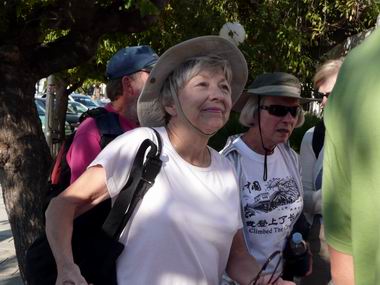 |
|
|
|
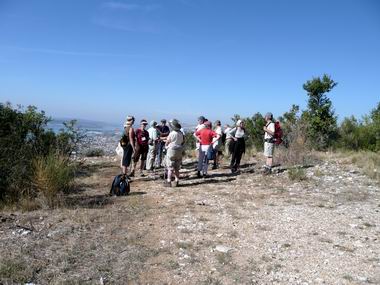 |
|
|
|
|
|
|
|
|
|
|
The Program:
We hiked in three areas beginning with Split, and then moved south to Makarska ending in Dubrovnik. The areas were on the Adriatic Sea known as the Dalmatian coast, and it is considered to be the Riviera of the Adriatic. The Romans gave it this name, which meant Sheppard, because of the local tribe called the Dalmati that inhabited the coast. Trogir was established by the Greeks in the third century and it means goat hill. The coast was conquered by the Greeks, the Romans, Venetians, the Ottomans, and Napoleon. The Dalmatian dog was originally imported from Egypt. People here are Slavic in ethnicity, but they have a slight Italian intonation in their pronunciation. Throughout the trip, the weather was pleasant, sunny and warm.
Split:
It was Friday, September 21, 2007
when we started the hiking program in Trogir near Split. We were driven
by a minibus to the famous park, Krka, pronounced Kirka. The Croation language
somehow skips some vowels. The park is very large and includes the big
Krka River, which is bigger than the Tennessee River. We hiked there and
saw many waterfalls. They were not very big, but they were beautiful and
colorful. Croatia has many falls but the big ones were not in this area.
We continued walking and came closer
to the waterfalls on walkways. The park was well marked, clean and well
maintained. We met vendors of nuts, lots of fresh and dried figs. I bought
some as well as some Jujube. We have lots of it in Palestine. It looks
like a brown olive with the meat tasting like a sweet tangy apple. I shared
it with the others in the group and they seemed to like it.
|
|
|
|
|
|
We saw a few displays about life back
in time and that was the way I lived back home except for washing clothes.
Water from the river was diverted into a small room bubbling out of a well.
Women washed clothes by dipping them into the well. They also planted wheat,
harvested and thrashed it in the air the same way we did back home. One
had to pay for using the bathroom in the park. I went there and signaled
that I had no money, because my ATM card did not work here. The attendant
signaled back, Euro? I gave her a bill and she returned the change to me.
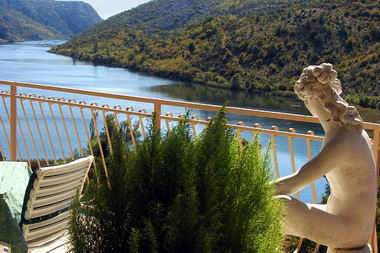 |
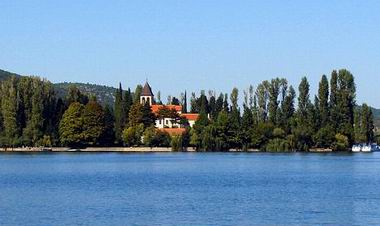 |
By noon, we took a boat ride down
the Krka River for about an hour and went through canyons. We arrived at
a restaurant on a hill in a picturesque setting. They had lunch prepared
for us. Trout fish was nicely cooked with vegetables and shredded cabbage
salad. The waiter assured us that the fish came from the clean cold river.
We were also served locally made brandy and wine. We then hiked until we
reached our bus. It was a tiring day, even though the distance was not
long, there was lots of climbing we had done.
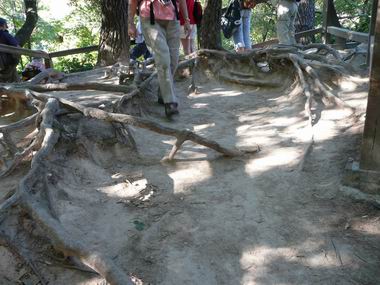 |
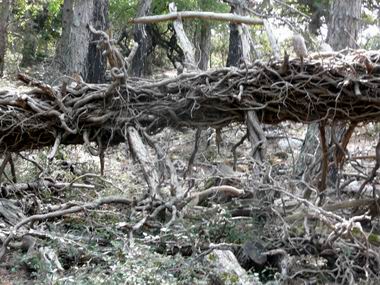 |
The old part of the town of
Trogir was built on a small island. It is a fascinating place to visit
with its narrow, cobblestone alleys. There was a small balcony and stairway
leading into one house. The scene was a depiction of Romeo and Juliet.
The center of the city’s activity is the church with its ornate furniture
and high bell tower which we climbed. It was a little uncomfortable to
do, because it was a spiraling narrow staircase, especially if a big person
was coming from the opposite direction. The view of the city by the coast
from the top of the bell tower was gorgeous. It has been said that long
ago, the town’s priest stood on the bridge connecting the island to the
mainland, raised his hand and stopped the plague from coming into town.
People also used smoke to keep their homes free of the disease. A statue
of the priest was erected by the bridge. People believe that when you rub
his big toe and make a wish it will come to pass.
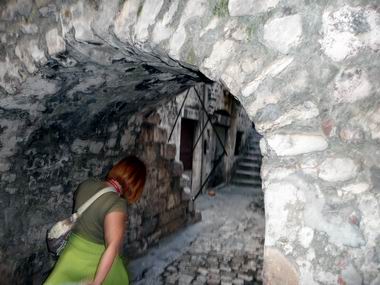 |
 |
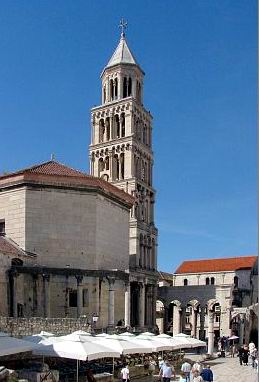 |
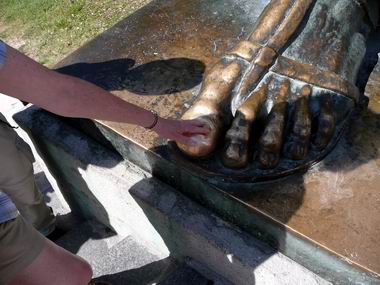 |
After a long but easy hike, we visited
the old part of Split, which was just as fascinating as Trogir with its
narrow stone alleys. The focus of this city was a spacious castle or palace
that was built by the Roman emperor, Diocletian who was from Split. The
emperor built the palace for his retirement days. He moved his seat of
power to Turkey, or Bezentya governing eastern half of the empire, including
Egypt, which later became the headquarters of the Eastern Orthodox Church.
 Split Split |
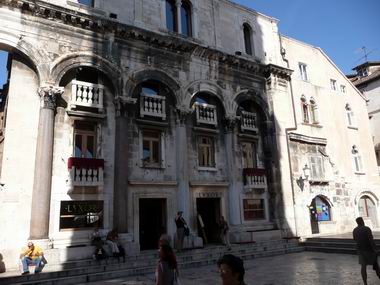 |
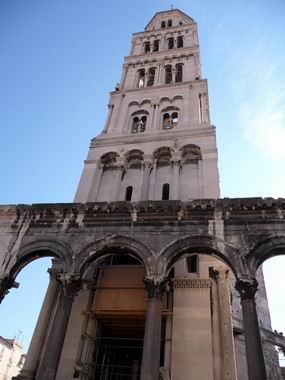 |
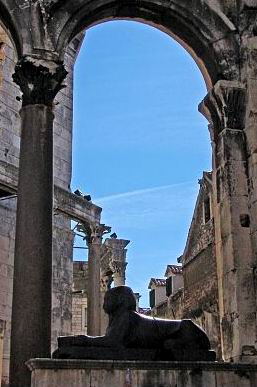 |
His palace design was inspired by the Pharaohs of Egypt with many arches. It had an olive press to extract oil. The columns were imported from there too. He made several small replicas of the Sphinx to decorate the palace. There was a basement in the palace which was used to store the garbage. It has recently been converted to gift shops for tourists. Residents built their houses around the palace. There are many coffee shops and restaurants now in the old city.
UNESCO decided that the historic Split
inner city, built around the Palace, will be included in the register of
the World Cultural Heritage.
|
|
 |